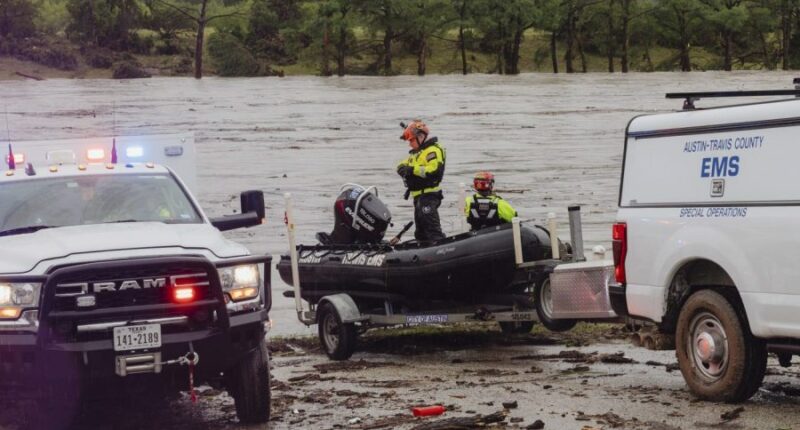Share this @internewscast.com

The flood disaster that struck Texas over Independence Day weekend was beyond the state’s ability to predict or fully manage, the state emergency management chief told the legislature on Wednesday.
“People are going to ask, ‘Well, what did you know that nobody else knew?’” Nim Kidd, head of the Texas Department of Emergency Management (TDEM), told the state’s Select Committees on Disaster Preparedness and Flooding during a special session, after weeks of state and national criticism of the disaster response.
His agency, Kidd said, “didn’t know anything that nobody else knew. The science is just not there yet.”
The committee hearing was held in the wake of the disaster that killed 135 Texans across more than two dozen counties, and in his opening remarks, chair and state Sen. Charles Perry (R) set the parameters of the state’s investigation.
The committee, he said, “will not armchair quarterback or attempt to assign blame. To do so and undermine the very goal in the committee’s creation.”
Instead, he said, “the goal of our committee is to find constructive policy solutions” to head off future loss of life.
That disclaimer came amid a storm of criticism of the local, state and federal response to the disaster, which ultimately killed 135 Texans across more than two dozen counties. Despite early allegations from TDEM that federal forecasts were inaccurate, current and former NWS forecasters have repeatedly argued that the state had enough information to know a disastrous storm was emerging over Central Texas.
And while Texas state officials such as Kidd and Gov. Greg Abbott (R) have repeatedly praised the response of the federal government, the Trump administration is under fire too after a series of articles in national media indicated that deep cuts to staff at the Federal Department of Emergency Management and a new process requiring approval for every expenditure over $100,000 in an agency that routinely deals in the billions had slowed down both rescues and aid.
Those cuts also led to the departure of regional NWS officials such as the Austin-based “warning coordinator” who took early retirement in April — specifically charged with making sure local officials are kept abreast of developing threats.
Texas Democrats including Rep. Joaquin Castro have argued these cuts could play a role in the confused situation on the ground in Kerr County, where officials took until more than an hour and a half after floods reached “emergency” levels to send out cell-phone notifications.
Climate change is prompting a significant rise in deadly natural disasters, but the panel opened with the assumption that the flooding was more like a one-off. Perry, describing a 9-mile high rain cloud pouring off a million gallons per minute onto the spiderweb of creeks and ravines across Central Texas, called it a “500 year-plus event.”
The “freak” nature of the disaster a fast-emerging “rain bomb” condensing over the Hill Country out of the churning remnants of Tropical Storm Barry made it “an absolute perfect storm,” KHOU meteorologist Pat Hammond said in a video Perry played for the committee. “We need to we also should have a deliberate conversation about the credentialing of emergency managers at the local level.”
The problem with such a storm, Hammond said, is that it “really pushes the science of meteorology to the limit. We are not at a point yet where we can pinpoint exactly where these other storms are going to pop up and where that flooding is going to happen.”
That ambiguity, he added, meant there was no way to identify where individual flash flooding can happen “pretty much until it’s starting to happen.”
That’s an area the National Oceanic and Atmospheric Association has been working on through the Severe Storms Laboratory (SSL) and that President Trump’s budget request would cut, former SSL head of research Alan Gerard told The Hill.
On the chopping block, Gerard said, are programs to develop tolls that “would let us tell a community three to six hours in advance that there’s a high probability of the type of intense rainfall that will cause a significant flash flood.”
As things were, Kidd told the committee, his department knew enough to pre-position resources but it was caught stretched over an area the size of Indiana, waiting for a disaster that ended up being far more localized.
As of the day before the disaster, Kidd said, “We had no idea where rain would fall, but we knew that there was moisture in the atmosphere throughout Thursday.”
In a beat-by-beat recounting of National Weather Service (NWS) updates, Kidd said that the warnings his team received did not coalesce into a flash flood warning until 1:15 the morning of the floods, or a flash flood emergency the highest level until 4:45 a.m.
“At 5:56, I personally got the first report of people trapped on roofs,” Kidd told the committee.
“We all know what happened after that.”
Three hours of lead time is unusually good for a flash flood twice what many jurisdictions get, former NWS forecaster Brian LaMarre told The Hill, though he emphasized that the fact that the warnings came overnight played a big role in the ultimate disaster.
Once the scale of the disaster became clear, Kidd said, the department was swamped by the response. At the height, he told the committee, the state had 2,700 employees on the ground and more than six times as many volunteers, a number that swamped the ability of the state to manage them.
During the response, he said that he found clear areas of literal communication breakdown: the San Antonio Fire Department’s radios didn’t work, “so they had some really cheap Chinese radios they were talking to each other on.
Ultimate authority in the crisis, he added, had rested with local officials. “I always say we are responsible we are not in charge. The responsibility of being in charge rests with local officials.”
With that in mind, Kidd said, the state “also should have a deliberate conversation about the credentialing of emergency managers at the local level.”
Under statute, he said, those officials can be “whoever the county judge, whoever the mayor appoints,” regardless of their experience.
“We’re better than that,” he said.














